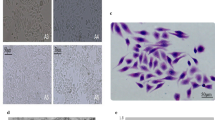Summary
Despite the importance of in vitro study of gastric cancer, there are very few established cell lines derived from human gastric carcinoma. We have recently established a new cell line derived from human gastric cancer which has the ability to produce tumor markers. This cell line has been designated JR-St. This cell line was derived from the cerebrospinal fluid of a 37-yr-old female patient who had metastatic brain tumor of signet ring cell gastric adenocarcinoma. This cell line has been maintained for more than 24 months through 80 passages with stable growth. PAS staining showed intracellular mucin granules. Transmission and scanning electron microscopy revealed cells with numerous microvilli and fine projections as well as intracellular granules, indicating mucin. This cell line had the ability to produce high concentrations of tumor markers such as carcinoembryonic antigen (CEA) and carbohydrate antigen (CA) 19-9. Thus this cell line should provide a very useful tool for the investigation of gastric cancer such as analysis of tumor markers as well as effects of anti-cancer drugs or growth factors.
Similar content being viewed by others
References
Barranco SC, Townsend CM Jr, Cacilda C, et al: Establishment and charactcrizaiton of an in vitro model system for human adenocarcinoma of the stomach. Cancer Res 1983;43:1703–1709
Dippold WG. Kron G, Boosfeld E. et al: Signet ring stomach cancer: morphological characterization and antigenic profile of a newly established cell line (Mz-Sto-1 ). Eur J Clin Oncol 1987;23: 697–706
Laboisse CL, Augeron C, Couturier-Turpin MH, et al: Characterization of a newly established human gastric cancer cell line HGT-1 bearing histamine H2-receptors. Cancer Res 1982;42: 1541–1548
Sekiguchi M, Sasakibara K, Fuji G: Establishment of cultured cell lines derived from a human gastric carcinoma, Jpn J Exp Med 1978;48:61–68
Ueda M, Fujiwara Y, Murakami A, et al: Establishment of a CSF-producing cell lines from a human gastric carcinoma and characteristics of the CSF produced by that cell line. International J Cell Cloning 1987;5:322–334
Dobrynin YV: Establishment and characteristics of cell strains from some epithelial tumors of human origin. J Nat Cancer Inst 1963;31:1173–1195
Hojo H: Establishment of culture cell lines of human stomach cancer. Origin and their morphological characteristics. Niigata Igaku Zasshi 1977;91:737–763 (in Japanaese)
Brinkley BR, Murphy P, Richardson LC: Procedure for embedding in situ selected cells cultured in vitro. J Cell Biol 1967;35:279–283
Paul, J: Cell and tissue culture, 5th ed, Churchill Livingstone, Edinburgh 1975
Chen TR: In situ detection of mycoplasma contamination in cell cultures by fluorescent Hoechst 33258 stain. Experimental Cell Res 1977;104:255–262
Watson SA, Durrant LG, Morris DL: Growth-promoting action of gastrin on human colonie and gastric tumour cells cultured in vitro. Br J Surg 1988;75:342–345
Leibovitz A. Stinson JC, McCombs WB III, et al: Classification of human coloreetal adenocarcinoma cell lines. Cancer Res 1976;36:4562–4569
Hidalgo IJ, Raub TJ, Borchardt RT: Characterization of the human colon carcinoma cell ine (Caco-2) as a model system for intestinal epithelial permiability. Gastrocntcrology 1989;86: 736–749
Tibbets LM, Chu MY, Vezeridis MP, et al: Cell culture of the mucinous variant of human coloreetal carcinoma. Cancer Res 1988;48:3751–3579
Togashi H, Terasaki PI, Chiba D, et al: A monoclonal antibody, CSTO-1, against a stomach adenocarcinoma-associatcd antigen. Cancer Res 1984;44:3953–3956
Sckine T, Hirohashi S, Kitaoka H, et al: A monoclonal antibody reactive with gastric carcinoma. Gann 1984;75:106–108
Watanabe M, Hirohashi S, Shimamoto Y, et al: Carbohydrate antigen defined by a monoclonal antibody raised against a gastric cancer xenograft. Jpn J Cancer Res (Gann) 1985;76:43–52
Yokota T, Takahashi T, Yamaguchi T, et al: Localization of radiolabeled monoclonal antibody S74 in human scirrhous type gastric cancer xenografts in nude mice. Gastroenteral Jpn 1987;22:698–702
Yokota T, Takahashi T, Yamaguchi T, et al: Monoclonal antibodies against human scirrhous carcinoma of the stomach. Gastroenteral Jpn 1987;22:565–570
Takayama T, Sakabe T, Fuji M, et al: In vitro production of human antibodies specifically reactive with human gastric cancer cells of established lines and autologous tissues. J Surg Oncol 1987;36:315–324
Ochiai A, Takanashi A, Takekura N, et al: Effect of human epidermal growth factor on cell growth and its receptor in human gastric carcinoma cell lines. Jpn J Clin Oncol 1988;18:15–25
Shibuya M, Yokota J, Ucama Y: Amplification and expression of a cellular oncogene (c-myc) in human gastric adenocarcinoma cells. Molec Cellul Biol 1985;5:414–418
Weinstock J, Baldwin GS: Binding of gastrin 17 to human gastric caricnoma cell lines. Cancer Res 1988;48:932–937
Winbron WB, Sheridan PJ, McGill HC Jr: Sex steroid receptors in the stomach, liver, pancreas, and gastrointestinal tract of the baboon. Gastroenterology 1987;92:23–32
Terano A, Mach T, Stachura J. et al: A monolayer culture of human gastric epithelial cells. Dig Dis Sci 1983;28:596–603
Terano A, Ivey KJ, Stachura J, et al: Cell culture of rat gastric fundic mucosa. Gastroenterology 1982;83:1280–1291
Author information
Authors and Affiliations
Rights and permissions
About this article
Cite this article
Terano, A., Nakada, R., Mutoh, H. et al. Characterization of a newly established cell line (JR-St) derived from human gastric signet ring cell cancer, producing tumor markers. Gastroenterol Jpn 26, 7–13 (1991). https://doi.org/10.1007/BF02779502
Received:
Accepted:
Issue Date:
DOI: https://doi.org/10.1007/BF02779502




